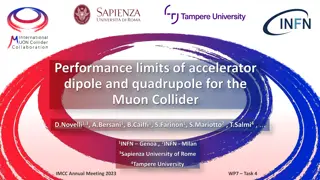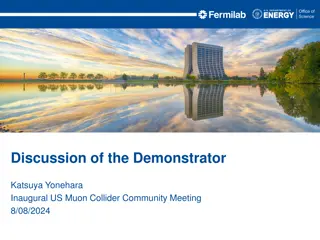ECFA Detector R&D Roadmap and International Collaborations Update
The ECFA Detector R&D Roadmap outlines collaborative efforts in particle physics research, focusing on high-field magnets, muon beams, and more. Task Forces are coordinating community consultations for future experimental programs, with a goal to fulfill strategic needs identified by the ESPP update
0 views • 28 slides
Ongoing Collaborations in Scientific Domains for NSF Review Preparedness
Ongoing and future collaborations between the High-Performance Algorithm-System-Hardware Co-Design (HAC) team with Machine Learning and Analytics (MMA) and Neuroscience areas are outlined. Collaborations include merging Pylog and HLS4ML into IceCube experiments, utilizing SPVCNN and GNN for neutrino
2 views • 4 slides
Anomalies in Particle Physics: Discoveries and Implications
Explore the intriguing anomalies in particle physics discussed by Andreas Crivellin, shedding light on phenomena like the anomalous magnetic moment of the muon, X17 particle, and neutrino anomalies. Discover the latest research findings and potential implications for the future of physics.
2 views • 42 slides
RF Considerations for High-Energy Muon Collider
This work package focuses on assessing feasibility issues and technological challenges of RF systems for a high-energy muon collider. Tasks include defining RF systems for acceleration and cooling complexes, addressing high gradients, beam loading, breakdown mitigation, and optimizing cavity distrib
0 views • 11 slides
Performance Limits of Accelerator Dipole and Quadrupole for Muon Collider
Utilizing Python code, the study analyzes the limits of accelerator dipole and quadrupole for the Muon Collider. Analytic formulas are implemented to assess the behavior of these components based on critical current density, operating temperatures, and superconductor materials. The study explores li
0 views • 17 slides
Accelerator Technology R&D Targets and Sources Overview
The SnowMass2021 Accelerator Frontier AF7 focuses on Accelerator Technology R&D, exploring targets and sources such as high brightness electron sources, muon sources, and high intensity ion sources. The community planning meeting discussed various Letter of Interest submissions outlining innovative
0 views • 7 slides
Neutron Multiplicity Measurement in Muon Capture on Oxygen in Super-Kamiokande
Explore the neutron multiplicity measurement in muon capture on oxygen using Super-Kamiokande, a water-Cherenkov detector located underground in Japan. Gadolinium was added to enhance neutron tagging efficiency, aiding in Supernova observation, proton decay rejection, and more. Neutron signals are t
0 views • 16 slides
Progress on R&D of the WCDA Experiment
This report details the progress of the Water Cerenkov Detector Array (WCDA) experiment conducted by Mingjun Chen on behalf of the WCDA Group. It includes information on the introduction to the experiment, R&D of the Water Cerenkov Detector Unit, measurement of muon events, water quality control, pr
0 views • 47 slides
Study of Muon Detection Efficiency in Thin-Gap RPCs
Conducted at the Max Planck Institute for Physics in Munich, this study focuses on the detection efficiency of thin-gap Resistive Plate Chambers. The research explores the construction, working principles, and experimental setup of RPCs, emphasizing the need for sensitive frontend electronics for hi
0 views • 14 slides
Muon Campus Operation Report for Week of January 2, 2023
Performance, activities, machine downtime, and G-2 experiment status for the past week at the Muon Campus were assessed in the operation report. Key highlights include G-2 beam delivery, maintenance work completion, impact of RF issues on studies, machine downtime details, and the integrated perform
0 views • 6 slides
Latest Update on Sci-ECAL MIP Results by Jiaxuan Wang
Jiaxuan Wang presents an update on Sci-ECAL MIP results as of March 8, 2024. The new method for muon energy reconstruction involves multiple fittings to exclude noise hits and obtain the real track and hits. The muon energy is estimated around 0.3049 MeV using new MIP calibration results. Despite pr
0 views • 4 slides
Muon Phase2 Upgrade: INFN Collaboration for Detector Enhancement
The Muon Phase 2 upgrade project aims to improve the performance of muon detectors for the HL-LHC conditions. Collaborating with INFN, the project focuses on maintaining excellent triggering and measurement capabilities under harsher conditions. Key aspects include existing detector consolidation, n
0 views • 17 slides
Designing Veto Cosmic Ray Detector for JPET Using GEANT4 Simulations
Creating the Veto Cosmic Ray Detector for JPET involves designing the current version of Veto JPET, incorporating 42 scintillators, detecting 4 GeV cosmic muons, generating cosmic muon distribution, and simulating energy deposition inside the veto scintillators. The process includes particle generat
0 views • 26 slides
High-Power Targets for Muon and Neutrino Production
Colin Johnson advocated for a mercury jet target as the next step for muon production post-ACOL. Current studies focus on a carbon target with proton beam parameters optimized for muon generation. Carlo Rubbia discussed a potential Muon-Collider Higgs Factory concept at CERN, sparking debate on muon
0 views • 11 slides
Developments in Muon Collider Technology at the Inaugural US Muon Collider Community Meeting
Discussion at the US Muon Collider Community Meeting highlighted advancements in muon accelerator technology, with a focus on the Demonstrator by Katsuya Yonehara. Key topics included the layout of the muon accelerator complex, achievements in ionization cooling, and the MERcury Intense Target. The
0 views • 14 slides
Challenges and Opportunities in DHCAL Technology for Neutrino Experiments
Funding cuts have impacted DHCAL activities for neutrino research, leading to limited progress. However, there is interest in utilizing existing technology for neutron yield measurements and muon energy evaluations. Efforts include addressing neutron interactions, optimizing materials, and revamping
0 views • 15 slides
Analysis of Muons for ASTRI at CCF/CTA Calibration Meeting
The analysis carried out at the CCF/CTA Calibration Meeting focused on muon detection for ASTRI using simulations and analysis software. Steps included pixel cuts, center and radius determination, image cleaning, radial and intensity profile computation, and reconstruction error evaluation. Results
0 views • 8 slides
Insights into Muon Tracking Efficiency in Wire-Cell Research
Explore the evaluation of single muon efficiency through detailed simulations in the Wire-Cell project. Discover advancements in track merging algorithms and the calculation of tracking efficiency using various variables. Dive into the challenges and progress in muon tracking within detector limitat
0 views • 13 slides
Insights from Pierre Auger vs. The Machine Final Report
Comprehensive analysis of UHECRs using hadronic models, machine learning, and neural networks. Research highlights muon deficit, explores high-energy cosmic rays' origin and composition, and addresses systematic uncertainties in shower reconstruction.
0 views • 13 slides
Muon Campus Operation Report & Performance Summary
This report provides an overview of the Muon Campus operations, including activities conducted, machine downtime, G-2 performance integrated for Run 4, and upcoming plans. Key highlights include beam delivery to G-2, maintenance work, beamline studies, and the status of experiments. The report also
0 views • 5 slides
Overview of Mu2e Slow Extraction Workshop at Fermilab by Vladimir Nagaslaev
This content discusses the Mu2e project at Fermilab, focusing on slow extraction techniques for beam delivery. It covers beam facilities, characteristics of Muon Campus, design requirements, beam losses, new MARS simulations, and losses in the extraction beam line. Details include beam kinetics, spi
0 views • 17 slides
Overview of Neutrino Beams in China: MOMENT Study Progress and Potential
The MOMENT study, initiated in 2013 in China, focuses on muon-decay medium baseline neutrino beam facility development. Using a Continuous Wave (CW) proton linac, the project aims to achieve 15 MW beam power for neutrino cross-section measurements and CP phase study. Recent progress includes the suc
0 views • 28 slides
Update on Rock Interaction Events by Palash Kumer Roy
This update discusses the selective retention of GENIE events likely to produce particles reaching the hall, interactions with rockboxes, muon birth rates in TMS, and muon momenta from upstream and downstream rocks. Discrepancies in muon rates are noted, prompting further investigation.
0 views • 14 slides
Compact Muon Radiography System for Investigation of Nuclear Reactor Fuel Status
A seminar presentation at LAL on May 23, 2013, discussed a compact muon radiography system designed for investigating the status of nuclear reactor fuel. The system, developed by researchers from the University of Tsukuba, involved the use of trackers with scintillators and muon detectors at various
0 views • 56 slides
Some Fermi News from Lab Status Meetings - Updates and Reports - January 2017
Updates from the recent TD/MSD/M&A Group Meeting on January 26, 2017, covering incidents, accelerator operations, future schedules, and important updates on various projects like MicroBooNE, MINERvA, NOvA, SeaQuest, g-2, LZ, and more. The report also includes notes on computing operations, LCLS-II d
0 views • 7 slides
Detector Assembly and Cryogenics Requirements for ILD Project
The ILD project involves assembling detectors using pre-assembled pieces on surface and lowering them into the assembly area. The detectors are equipped with various components like muon detectors, solenoids, and calorimeters. Magnetic field measurements are carried out during the assembly process.
0 views • 11 slides
Investigating Cosmic Rays with Student Researchers at Liceo Amaldi
A group of 40 students from Liceo Amaldi have been actively involved in the Extreme Energy Events project, studying cosmic rays and telescopic data. Utilizing software like Lazarus, Excel, and Root, they have analyzed the speed and angular distribution of cosmic ray muons. The students also went to
0 views • 19 slides
Production and Measurement of Beryllium-10 in Quartz
Beryllium-10 (10Be) is produced through cosmic ray spallation and muon-reduced reactions, with production rates influenced by factors like altitude and latitude. Measurement involves accelerated mass spectrometry on pure quartz samples, where the ratio of 10Be/9Be is determined relative to a standar
0 views • 12 slides
Accelerator Operations Update - November 9th, 2024
Progress and updates from the Accelerator Operations team include switch work completion, upcoming safety system testing, beam sign-off projections, Muon Mu2e extraction progress, BNB beam status, and future plans for beam studies and replacements. Key activities such as Booster studies, Breaker rep
0 views • 5 slides
Tìm hiểu về nguyên tắc lên thực đơn cho người béo phì muốn giảm cân
Ch\u1ebf \u0111\u1ed9 dinh d\u01b0\u1ee1ng \u0111\u00f3ng vai tr\u00f2 r\u1ea5t quan tr\u1ecdng trong qu\u00e1 tr\u00ecnh gi\u1ea3m b\u00e9o. B\u1ea1n h\u00e3y \u0111\u1ecdc b\u00e0i sau \u0111\u1ec3 n\u1eafm r\u00f5 nguy\u00ean t\u1eafc khi l\u00ean
0 views • 3 slides
Chế độ ăn uống thích hợp cho mẹ muốn giảm cân sau sinh
H\u01b0\u1edbng d\u1eabn 5 c\u00e1ch \u0103n gi\u1ea3m c\u00e2n sau sinh m\u00e0 v\u1eabn cung c\u1ea5p \u0111\u1ee7 d\u01b0\u1ee1ng ch\u1ea5t cho s\u1ea3n ph\u1ee5 v\u00e0 tr\u1ebb s\u01a1 sinh b\u00fa m\u1eb9.
0 views • 4 slides
Accelerator Upgrade Workshop Summary
Comprehensive analysis of the recent ACE Science Workshop discussions on accelerator upgrades for the LBNF program, including key points on both ACE RCS and ACE Linac approaches, muon collider considerations, high-power targetry R&D needs, technical/performance risks, and proposed next steps for sys
0 views • 12 slides






























